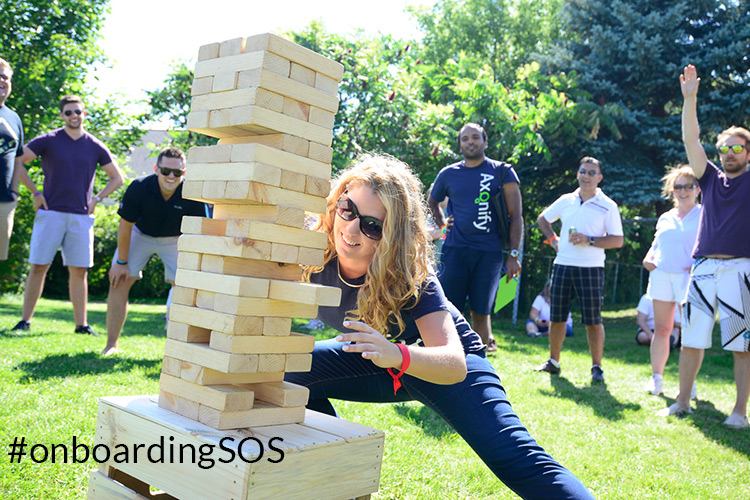Onboarding begins before Day 1
When was your first experience with your current employer? Was it your first day of work? Was it when you applied for the job? I’d guess that, for most of us, our first experience occurred much earlier—perhaps even several years prior—but in a different context. While your relationship with the organization may have been quite different before you considered it as a potential employer, your onboarding actually began the moment you first learned about the company’s existence.
I started working for Axonify in 2016, but my experience with the company began in 2013—as a customer. While I only engaged with the company when I needed help or something new was released, I quickly became exposed to Axonify’s culture. I felt taken care of when employees responded to my requests in a timely manner. I felt appreciated when my suggestions were implemented within the product. I still remember first seeing this photo of Tori in the “About Us” section of the Axonify website and thinking “that seems like a fun place to work.”

I had a picture in my mind of what working at Axonify would be like for years before I joined. If that picture failed to, at least, somewhat match reality, I would have had a problem engaging in my role. Luckily, my experience as an Axonify employee is much better than giant Jenga! But this story isn’t unique when it comes to the early-start nature of onboarding. Pre-Axonify, I also had considerable experience with other past employers, including Disney (every family vacation) and AMC (many trips to the local theatre), before joining their teams. It was those experiences that drew me to the organizations in the first place.
So what does this have to do with L&D? Well, that’s kinda the point behind this post …
L&D doesn’t own onboarding
An effective onboarding strategy is just as much about culture and fit as it is about knowledge and skill. Onboarding is a collaborative effort that involves everyone who touches the employee experience—before and during their time with the company. But, even if L&D doesn’t own the entire process, the L&D team is in a position to play a central organizing role, especially in this early part of the story. L&D must recognize how this “pre-boarding” component fits alongside the more familiar chapters, like knowledge and skill development, that we’ll address in the future posts.
As we explore the full range of onboarding topics, here are a few ideas you can share with your strategic partners to help set your new employees up for success—before they actually start working.
Always Be Recruiting
It’s not quite an Alec Baldwin quote, but it has a similar ring to it. Every message we send into the world about our organizations is a potential recruitment message. Every tweet. Every YouTube video. Every customer experience. These activities tell people who aren’t “in the know” who we are and what we value. People use these messages to create mildly uninformed pictures of what it would be like to work for your company. Therefore, if you want to attract the right talent, your messages must align with the type of culture these folks want to experience.
Given the ubiquitous nature of corporate messaging and the ease with which people can access information, this principle goes well beyond the human resources and recruiting teams. Marketing, communications, public relations … every employee plays a part in sharing your company story with the world. Sure, some have more reach than others, but some of your best recruitment options are likely within your existing employee network. Every employee should be enabled to support the company by identifying potential talent. Each individual must be armed with an understanding of what the organization is looking for—in terms of both knowledge/skill/experience as well as cultural fit. This will not only save time and effort by avoiding a lot of formal recruiting processes, but it will also yield more right-fit talent that already have a foundational understanding of your organization.
Find People Who Already Love Your Company
Why do people like going to the Apple Store so much? Sure, they sell some nifty products, but I could also just order what I need online. Their retail experience is second to none, and a big part of that is its staff. Apple doesn’t just hire generic retail employees. The company finds people who know Apple products and love the brand. The company doesn’t have to indoctrinate employees into the system and hope they develop a passion for the company. They already have it, and Apple is just giving them a formal reason to share it. This—and the nifty products—has enabled significant business results for Apple.
No, we don’t all work for Apple. Your company may not have developed as wide a brand affinity as it has. Regardless, in order to be a successful business, you must have customers, suppliers and partners. Could you leverage these existing relationships in order to find right-fit talent? How can interaction data, such as customer and partner loyalty, be used to find people who love your brand and may have a desire to become part of it? Are you fostering these relationships and getting to know people in such a way that you could identify a right-fit candidate? Sourcing employees in this way will help you cut down on the onboarding requirements necessary to get them integrated and productive in their new roles.
Match Facade and Reality
When you read “About Us” web pages, every company sounds like an amazing place to work. Unfortunately, we all know that’s not the case. Employees will be quick to recognize when the facade doesn’t match the day-to-day reality, and this will damage the onboarding experience. It may even result in a quick exit for those who feel they were falsely sold a bill of goods.
As is true of any marketing effort, we must ensure our external messaging is an accurate depiction of the internal experience. Sure, there will be variations based on role, team, project, manager, etc. And, of course, we want to appear awesome to attract the best people. But we must also be as honest and transparent as possible so the onboarding and continued learning experience is not disrupted by early distractions. For example, you can provide late-stage candidates with an opportunity to visit the workplace and speak with their team to get a real-world view of their potential role. You can also vet recruitment messaging with existing employees to ensure alignment with the on-the-job reality. Overall, the transition from candidate to employee must be as seamless as possible to keep the focus on accelerating capability and performance outcomes.
Get Managers Involved
If anyone really owns the onboarding experience (and no single entity does, in my opinion), it’s the frontline manager. This person will ultimately be held accountable for the new employee’s success. Therefore, s/he should play an intimate role in all stages of the onboarding experience—before, during and after a person gets started. Too often, managers are left out of the process due to other priorities, only to get engaged with the new team member after they are deemed “ready.” Then, they are surprised when an employee quickly flames out for reasons that should have been clear before Day 1.
The manager must play as big a role as possible in determining the fit of a candidate, as s/he best understands the day-to-day workings of the operation and can provide clarity on the roles and responsibilities. Likewise, the candidate should be given the opportunity to engage with their potential manager(s) as early as possible so they can decide if they are a good fit too. There’s a reason for the saying “employees don’t leave jobs; they leave managers.” Get managers involved in the onboarding process early and often to begin the coaching relationship and lessen the likelihood of surprises and negative repercussions later on.
Provide Early Learning Opportunities
This is where L&D can get proactive before the employee formally joins the organization. You may not be able to “require” the completion of learning activities until the candidate is on the payroll. However, that doesn’t mean that you cannot provide opportunities for knowledge growth as part of the early onboarding experience. This can help you focus on role-specific needs on Day 1 so you can get the employee to his/her required level of initial capability even faster. Here are a few light “pre-boarding” ideas that can be especially useful for late-stage candidates:
- Candidate Portal – Provide access to an online portal that includes introductory content about the company, including history, culture, industry and mission. This will not only help you check off some early onboarding requirements, but it will also help the employee better prepare for the interview process.
- Role Requirements – Provide a detailed list of knowledge and skill requirements— beyond the basic job description—so the employee clearly understands what will be expected and have the chance to pursue self-directed learning opportunities to get a head start.
- Job Shadow – Bring the candidate in for a light shadow experience with a peer or manager so s/he can see the organization in action and begin to absorb some initial workplace knowledge.
- Simulation – Invite the candidate to participate in an online workplace simulation/game experience that asks him/her to make decisions (and mistakes) similar to those they will encounter on the job. This can even feed into your Day 1 learning strategy for the new employee, as we’ll explore in a later post.
It’s easy to pass off responsibility for onboarding when it’s viewed as a program with a firm start and finish. However, as I posited in our first #onboardingSOS post, the journey to become the perfect employee never ends. Shifting the mentality from training program to employee experience reveals the true collaborative nature of onboarding. Every function and team tells the company story and prepares employees for their roles in their own ways—even before someone officially joins. By acknowledging this reality and engaging key partners in building a holistic employee onboarding experience, L&D can better focus its Day 1 sights on fostering the knowledge and skills necessary to help someone become successful on the job as quickly as possible. But that’s for another post …
Want to keep reading? The next post in our #OnboardingSOS series covers the 3 foundational onboarding principles for driving employee confidence and capability.
